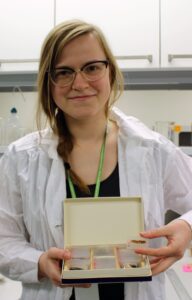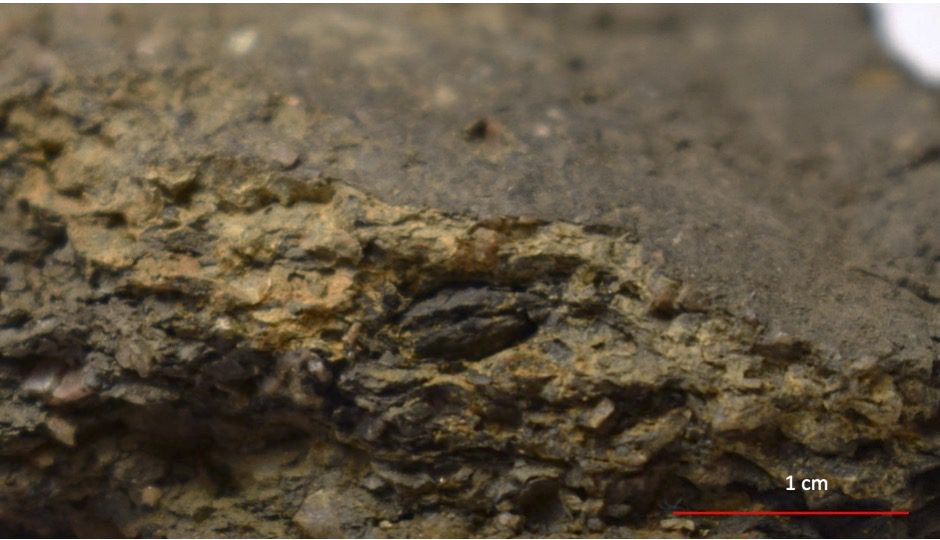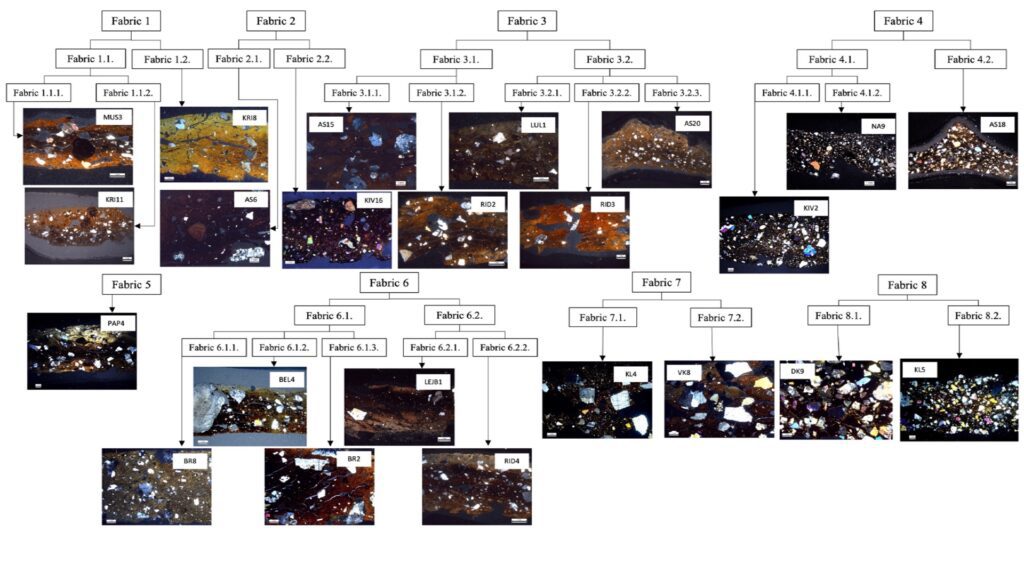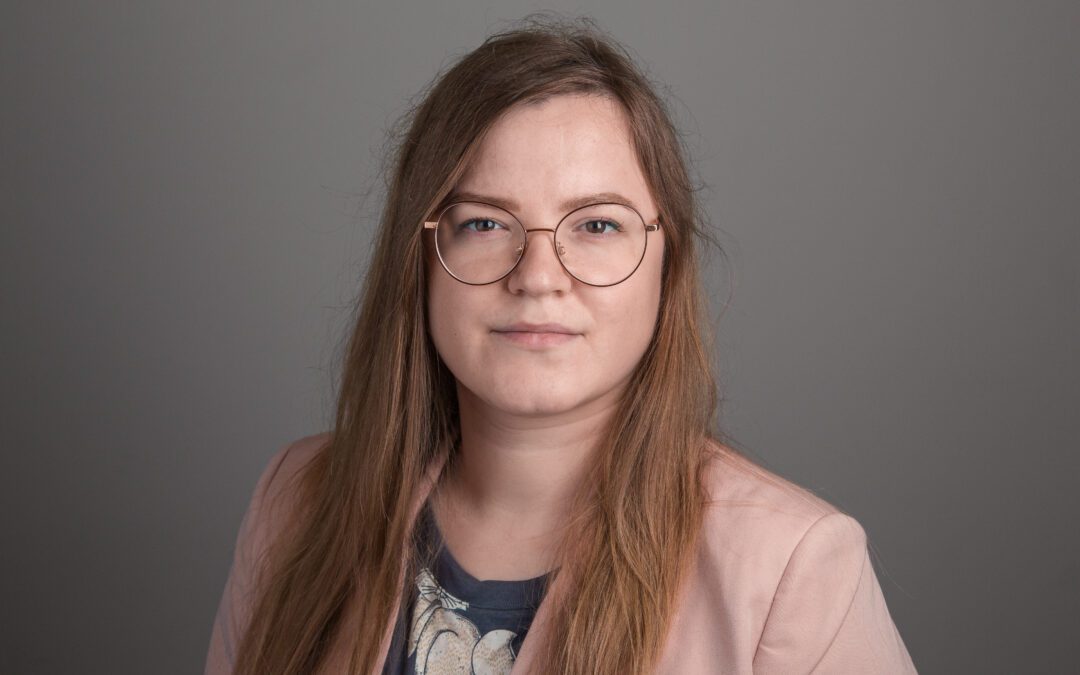AABS is pleased to recognize Vanda Visocka for the completion of her dissertation “Pottery production, function and meaning during the Bronze and Pre-Roman Iron Age in the Eastern Baltic,” for which she received the 2021–2022 Aina Birnitis Dissertation-Completion Fellowship in the Humanities for Latvia.

©T. Grīnbergs, 2023
Vanda Visocka defended her PhD with the dissertation “Pottery production, function and meaning during the Bronze and Pre-Roman Iron Age in the Eastern Baltic” on 13th of December 2022 at the University of Latvia (LU) Faculty of History and Philosophy. She has been interested in ceramic analysis since her bachelor’s studies, which she finished in 2015 at the LU Faculty of History and Philosophy. While pursuing her masters’ studies at the LU Faculty of History and Philosophy, she was an Erasmus+ Mobility studies participant in Stockholm University, Sweden in 2016, where she pursued ceramic petrography analysis and other laboratory techniques under the supervision of Ole Stilborg, Sven Isaksson and Kerstin Lidén. Vanda Visocka finished her masters’ studies in 2017 and then began her doctoral thesis at the LU Faculty of History and Philosophy.
The Impact of an Award: Report from Vanda Visocka
After the completion of her dissertation, Vanda Visocka submitted a reflection to AABS.
We thank her for her permission to publish her thoughts, which have been lightly edited.
In 2021 the dissertation project “Pottery production, function and meaning during the Bronze and Pre-Roman Iron Age in the Eastern Baltic” was funded by Aina Birnitis Dissertation-Completion Fellowship which allowed me to analyze the archaeological and geological materials from the Eastern Baltic region (nowadays territories of Estonia, Latvia and Lithuania) as well as to buy equipment – petrographic microscope, which was used in the dissertation and will be used in the future research. The dissertation was defended successfully on 13th of December 2022.
Pottery is a sensitive material to change, i.e., when the value of societies changes – the material culture changes as well, and pottery is often first one to develop new visual aesthetics. This allows us to analyze the general trends – traditions, transfer of technological knowledge and influences between prehistoric communities as well as technological development of pottery craft. The tradition and technological development of ceramic vessels provide insights into everyday life in prehistoric communities, such as quality, aesthetic values, ideology, transfer of technological knowledge and inter-community relations.
The aim of the dissertation is to analyze pottery production, function and meaning, and its role in the societies of the Eastern Baltic Bronze and Pre-Roman Iron Age. In order to reach this aim various sources were analysed such as pottery assemblages, geological and archaeological survey and excavation documentation as well as surveyed and sampled local small clay beds in surroundings of the settlements. Next to basic analysis which includes spatial analysis, statistics, and visual observations of the vessels, such as pottery shape, surface treatment and ornamentation, laboratory methods, such as ceramic petrography, wavelength dispersive X-ray fluorescence spectroscopy (WD-XRF), organic residue analysis via gas chromatograph – mass spectrometer (GC-MS) and radiocarbon 14C dating via accelerator mass spectrometry (AMS), was used. All these analyses on household pottery allows us to understand the main tendencies of the pottery craft and its role in the prehistoric communities such as provenance and technological traditions of the pottery, its chronology and thus changes during the Bronze and Pre-Roman Iron Age (1800–1 cal BC) as well as its function – for what was the vessel used – cooking, storing or feasting? In turn analysis of burial pottery allows us to understand the meaning behind these vessels and their role in the notions of afterlife.

Figure 1. Vanda Visocka with thin section collection in 2018 at rock research laboratory, University of Latvia Faculty of Geography and Earth Sciences. Photo ©S. Mačute

Figure 2. Charred grain in the clay paste of a vessel from Asva (TLÜ AI 4366: 1429). Photo: Vanda Visocka.
This is the first study which analyses pottery as a craft and its meaning as well as function in the Eastern Baltic region prehistoric communities by using uniform and interdisciplinary methodology. This allows us to understand the main tendencies as well as transmission of technological knowledge and techno-social aspects of the pottery craftmanship in the Eastern Baltic and put it in the context of whole Baltic Sea region.
The main conclusions are as follows:
- The data show that potters used good quality glacial till clays or refined till clays. The study of the clay deposits shows that potters had access to good quality plastic clays close to their settlements. According to chemical analyses, potters used very plastic clays rich in Aluminium and Iron. However, the surveyed clay samples generally did not group chemically with the clays used in pottery production, so the clay deposits found were not used in the production of these vessels.

Figure 3. Graph of pottery fabric groups based on thin section petrographic data. Most representative thin sections have been chosen as samples in this graph (micrographs in XPL, author: V. Visocka)
- Various materials have been added to the clay paste as temper: granitic rock, sand, grog (crushed pottery), quartzite and possibly organics. Various experiments and observations suggest that dung matter could be used as a tempering material as well. Petrographic analyses have identified eight groups of clay fabrics with several subgroups, indicating different practices in the production of the pastes which might be dependent either on quality of clays or potters’ preferences. Importantly, there are no paste recipes that are specific to a single site, indicating a transfer of knowledge between Eastern Baltic communities. Paste recipes do not correlate with different time periods, i.e., the petrographic data show that there is not much difference between recipes from the Early Bronze Age and those from the first half of the Pre-Roman Iron Age. On the other hand, the visual analyses show that the tempering added to the pottery clay paste in the second half of the Pre-Roman Iron Age were not dense and much coarser than for Bronze Age vessels.
- The function of the pottery has been interpreted by analysing the deterioration characteristics of the vessels, the space and context, as well as by analysing the organic residues. The data indicate that, in general, the location of ceramic finds correlates with their possible function: the highest concentrations of vessels found at settlements are found in objects associated with food preparation and storage, indicating their primary function. Tableware was found only at the Asva hillfort, where it was probably used for a specific purpose, namely feasting. The existence of coarse vessels, with small and medium-sized pottery, probably used for eating and drinking, indicates social differentiation – fine vessels for the elite, ordinary ones for the rest of the community (Figure 4).

Figure 4. Asva coarse and fine ware (TLÜ 3994, 3658:492). Photo: V.Visocka
- The ceramics of the settlements also played a socio-ideological role: in some of the settlement, offerings were found, where ceramic vessels were found together with the bones of animals used for subsistence, suggesting the role of food and the association of ceramic vessels with it. However, the socio-ideological role was best reflected in the funerary vessels, both in the urns and those brought with the deceased in the afterlife, as well as those used in funerary rituals. Signs of use, such as soot and food crust on the pottery, indicate that some of these urns were previously used in domestic contexts. This is also observed in the organic residue analyses.
Overall, the data provide important information on the production and role of pottery in the Bronze Age and Pre-Roman Iron Age communities in the Eastern Baltic. Pottery was made with its intended function in mind and was used and reused during its lifetime both in the household and as burial urns. All the findings indicate that ceramic vessels and pottery as a craft were an important and invaluable part of prehistoric communities.

Figure 5. Vanda Visocka conducting her research in the field.
In future research it would be important to compare the ceramic traditions of the Eastern Baltic with those of neighbouring regions in order to find out the interregional transfer of knowledge. It would be particularly important to understand the ceramic traditions of the Lusatian archaeological culture in order to compare whether there are similarities with the Eastern Baltic pottery. There are still unanswered questions regarding the inland pottery traditions in the Eastern Baltic, with inland potters seemingly being more conservative in their approach to pottery production, but additional research, with a larger base of inland household and burial assemblages, is needed to confirm this thesis.
I am very grateful to Aina Birnitis Dissertation-Completion Fellowship and AABS for funding my PhD project, it has allowed me to work and focus on my research which otherwise would be impossible to do without such support, and to finish and successfully defend my dissertation.
– Vanda Visocka
Vanda Visocka
What is the Birnitis Fellowship?
The Aina Birnitis Fellowship supports a year of research and writing to help advanced graduate students in the humanities in the last year of Ph.D. dissertation writing. The fellowship provides a $21,000 stipend for one year plus $1,000 for university fees.
The application deadline for academic year 2023-2024 was February 1, 2023. Applications were evaluated by the AABS 2023–2024 Grants Committee consisting of AABS VP for Professional Development Dr. Kaarel Piirimäe, AABS President Dr. Dovilė Budrytė, and AABS Director-at-Large Dr. Daunis Auers. Award notifications will be made in April 2023.
Other Grants and Fellowships News
Sophie Peng Awarded 2024-2025 Baumanis Grant
The Association for the Advancement of Baltic Studies is pleased to announce that Sophie Peng has been awarded the 2024-2025 Baumanis Grant for Creative Projects in Baltic Studies for her project “Lace Narratives: Hand-work (EE: Käsi-Töö)." The Baumanis Grant is an...
Jelena Šalaj Awarded 2024-2025 Baumanis Grant
The Association for the Advancement of Baltic Studies is pleased to announce that Jelena Šalaj has been awarded the 2024-2025 Baumanis Grant for Creative Projects in Baltic Studies for her book project "North of Photography." The Baumanis Grant is an award made to...
Ornela Ramašauskaitė Awarded 2024-2025 Baumanis Grant
The Association for the Advancement of Baltic Studies is pleased to announce that Ornela Ramašauskaitė has been awarded the 2024-2025 Baumanis Grant for Creative Projects in Baltic Studies for her project "Art Across Borders: The Baltic Visual Legacy Project." The...




